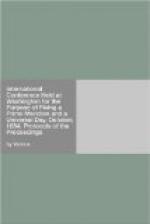In order that a discussion may proceed, it is necessary to agree on a given basis from which to start, and it is extremely difficult to agree upon a basis if there are considerations of sentiment introduced, because such considerations are peculiar to each person.
He therefore wished to propose this question again to the Delegate of France, namely, what advantages can we derive from fixing upon a neutral meridian?
Mr. JANSSEN, Delegate of France, said:
Professor NEWCOMB asks me to point out the advantages of a neutral meridian. These advantages are of two kinds—they are of a geographical nature and a moral nature. Let us examine the first. By placing the initial meridian between Asia and America, we get away from the centres of population, which is almost indispensable in view of the change of dates. We divide the world into two parts, the Old World and the New. The advantage of drawing the prime meridian through the ocean has always been understood, and it was precisely for this reason that Marinus of Tyre, during the first century, placed it at the Fortunate Isles, west of the African Continent. It is idle to urge the difficulty of fixing such a meridian as an objection. Astronomy is so far advanced in our day as to enable us to make this calculation with all desirable accuracy.
As to the methods of obtaining this meridian exactly, there are several. I have already spoken of them, but I return to the subject, since more details are desired. These methods fall under two principal heads. We can, and that is the ancient idea, choose some remarkable physical point—as, for instance, the extremity of an island, a strait, the summit of a mountain—and determine approximately the distance in longitude of this point from the points of reference, which are at present the observatories. This method, if all the precision that science can now attain is required, would be costly in certain cases. For the Azores the expense would be small, because of the proximity of the telegraphic cables; it would be much greater for Behring Straits. On the hypothesis of the employment of this method, it would evidently be necessary to place our meridian at the Azores.
According to the other method, it is not the physical point which is fixed, but simply the distance of the assumed origin from the points of comparison. For example, admit that the general definition of our prime meridian was that it should pass through the middle of Behring Straits. To obtain its theoretical definition, we should obtain a position of this point, either by summary observations of the nature of hydrographic surveys, or by the aid of existing information, and the longitude thus obtained would be connected with the observatories best connected with each other. A list of the differences of longitude would become the definition of our meridian, and not the physical point in the sea which marks the exact middle of the




